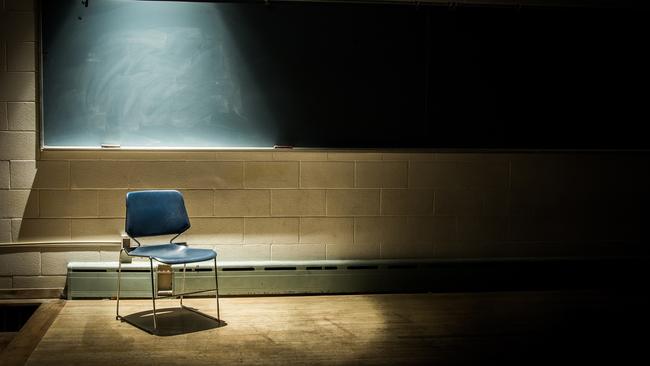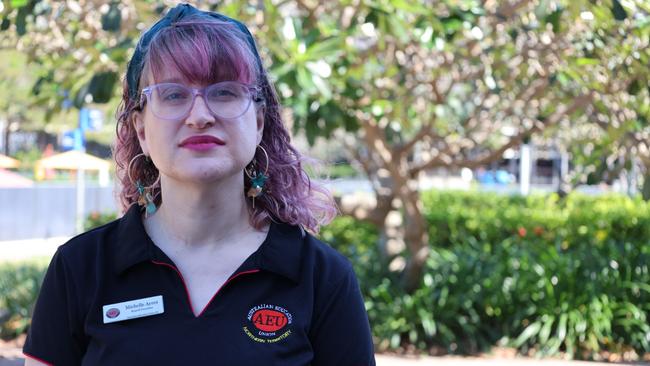Remote Territory teachers claim NT Education Department failing remote schools and students
Even though most of the Territory’s schools are in the bush, remote schools are only getting a 10 per cent share of the Education Department’s maintenance budget.
News
Don't miss out on the headlines from News. Followed categories will be added to My News.
Update, May 16: Even though 71 per cent of the NT’s public schools are in the bush, only 10 per cent of an infrastructure repair fund has been allocated to remote schools.
Territory teachers say the Education Department is failing 44 per cent of the NT’s student population by failing to improve remote and very remote school infrastructure.
But the department has not confirmed if it will investigate how remote student outcomes are affected by poorly maintained schools.
“All schools are required to provide a safe environment for students and strive to provide dynamic and fit-for-purpose learning facilities,” an Education Department spokeswoman said.
“We work closely with (the Department of Infrastructure, Planning, and Logistics) to prioritise infrastructure improvements within funding allocations provided.”
Ali Curung School and Yirrkala School were the only two remote facilities listed for new capital works – costing a combined $10.23m – under a $100m infrastructure upgrade pledge in the Education Department’s record-breaking budget.
The spokeswoman said it was up to schools to submit Urgent Minor Repair requests to DIPL – or to engage contractors directly for small problems.
She said DIPL assigned contractors to each job, though response times could vary depending on the availability of materials and labour.
One remote teacher previously told the NT News it took four weeks for a septic tank overflow to be fixed after a UMR request – which left only one functioning toilet.
The department did not deny how long the repairs took and said a “program of work” would be delivered to address further problems.
“The school has seven operational toilets,” the spokeswoman said.
“The issue was attended to and rectified by DIPL contractors.
“An audit of the school’s waste and water issues was also undertaken to identify longer-term solutions for issues that result from environmental factors impacting on plumbing, such as mineral build-up.”
Another teacher told this publication boarding students enrolled in a government-funded school were sleeping on mattresses on the floor.
But the Education Department denied being made aware of overcrowding in any boarding facilities.
Opposition Education spokeswoman Jo Hersey said teachers had “lost faith in the Labor government who continue not to listen to their concerns”.
Mrs Hersey said the CLP’s three-pronged plan to support educators and students focused on retaining quality teachers, boosting attendance, and lifting literacy and numeracy rates.
She said the CLP would support teachers by addressing crime in the NT and giving financial certainty to educators by offering more permanent positions.
“The CLP will restore the safety of students and staff by expanding School-Based Policing and ensure qualified school counsellors are based in schools and properly resourced,” she said.
‘Death of remote schools’: Teachers share harrowing tales of failed system
Initial, May 12: “We treat prisoners better than we’re treating these kids.”
Students sleep in cramped dorms on mattresses on the floor.
Children choose between queuing in long lines to use the school’s only working toilet, or urinating on trees if the wait is too much to bear.
And a billion-dollar promise to right the wrongs of historic underfunding has so far left little impact.
This, teachers say, is examples of the Territory’s dystopian education system which is leading to the “death of remote schools”.
Speaking to the NT News on the condition of anonymity, they said the grim picture is often glossed over because remote schools aren’t as easy to access as Darwin and Palmerston’s urban schools.

“We’re a 350 kilometre drive from Alice Springs, it takes a long time to get out there,” she said.
“We’re the forgotten community.”
She said their school was so forgotten that her students were left without access to more than one toilet after a septic tank overflow.
“(The overflow) had shut down all of the toilets in our school – there was only one functioning staff toilet that for about four weeks,” she said.
“We were sharing with 60 students and five teachers.
“We had children so in need of the toilet, they had to go other places – it’s not acceptable; infrastructure needs to be updated.”
Another teacher, who also wished to remain anonymous, said the billion-dollar boost to public schools had exciting potential if it is shaped to meet every community’s unique needs – especially in remote contexts.
In March, the NT and federal governments committed to investing at least an additional $1.087 billion into the Territory’s public education system from 2025-2029.
The welcome funding would bring schools to the full School Resourcing Standard for the first time in NT history, but advocates say the money must be spent with care and consultation.
“Remote schools have different needs for their kids than in a rural area, than they would in an urban area,” The teacher said.
The rural educator said the Australian Education Union NT’s recent conference made those needs clear.
One motion, for example, called on the government to allocate targeted funding for schools with boarding facilities attached based on student numbers.
“At a government school that has boarding facilities, students were sleeping on mattresses on the floor, crammed into the space available,” the teacher said.
“The kids were having to prepare their own meals using two electric frying pans.
She compared the remote school’s situation with that of a nearby one which had “two students in a room and a cook to prepare meals” because “they’ve got the funding for it”.

AEU NT branch president Michelle Ayres said she was discouraged by the state of the Territory’s education system after the union’s annual conference.
Ms Ayres said she believed many teachers did not trust the Education Department to guide schools towards a better future for students and educators.
“What we need from the department right now is for them to be listening from the ground up, rather than directing from the top down,” she said.
“We’ve got everything set up to succeed, we just need the department to believe and invest in the quality of our people.”
The NT News put questions to the Department of Education, including their response to claims of students sleeping on mattresses on the floor due to a lack of appropriate boarding facilities, and how the additional $1.087bn for public schools would be spent.
A response was not received by deadline.
More Coverage
Originally published as Remote Territory teachers claim NT Education Department failing remote schools and students




